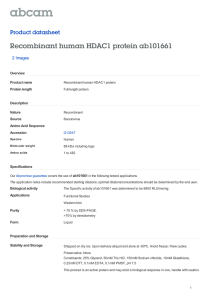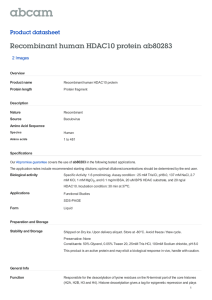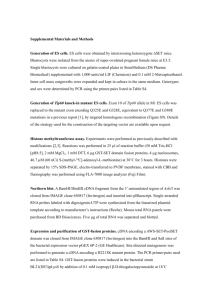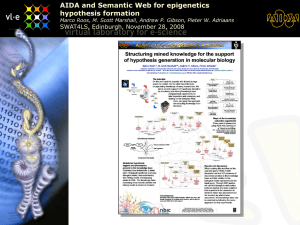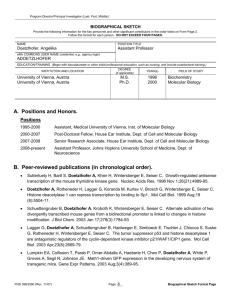Chromatin deacetylation by an ATP-dependent
advertisement
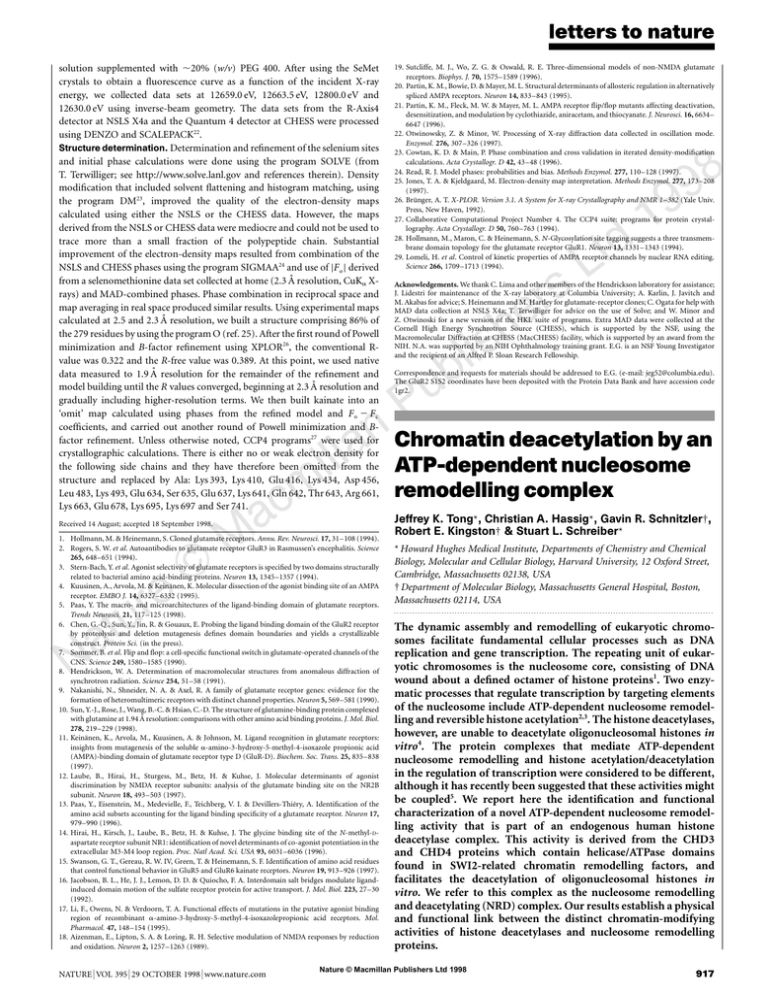
letters to nature solution supplemented with ,20% (w/v) PEG 400. After using the SeMet crystals to obtain a ¯uorescence curve as a function of the incident X-ray energy, we collected data sets at 12659.0 eV, 12663.5 eV, 12800.0 eV and 12630.0 eV using inverse-beam geometry. The data sets from the R-Axis4 detector at NSLS X4a and the Quantum 4 detector at CHESS were processed using DENZO and SCALEPACK22. Structure determination. Determination and re®nement of the selenium sites and initial phase calculations were done using the program SOLVE (from T. Terwilliger; see http://www.solve.lanl.gov and references therein). Density modi®cation that included solvent ¯attening and histogram matching, using the program DM23, improved the quality of the electron-density maps calculated using either the NSLS or the CHESS data. However, the maps derived from the NSLS or CHESS data were mediocre and could not be used to trace more than a small fraction of the polypeptide chain. Substantial improvement of the electron-density maps resulted from combination of the NSLS and CHESS phases using the program SIGMAA24 and use of jF o j derived from a selenomethionine data set collected at home (2.3 AÊ resolution, CuKa Xrays) and MAD-combined phases. Phase combination in reciprocal space and map averaging in real space produced similar results. Using experimental maps calculated at 2.5 and 2.3 AÊ resolution, we built a structure comprising 86% of the 279 residues by using the program O (ref. 25). After the ®rst round of Powell minimization and B-factor re®nement using XPLOR26, the conventional Rvalue was 0.322 and the R-free value was 0.389. At this point, we used native data measured to 1.9 AÊ resolution for the remainder of the re®nement and model building until the R values converged, beginning at 2.3 AÊ resolution and gradually including higher-resolution terms. We then built kainate into an `omit' map calculated using phases from the re®ned model and F o 2 F c coef®cients, and carried out another round of Powell minimization and Bfactor re®nement. Unless otherwise noted, CCP4 programs27 were used for crystallographic calculations. There is either no or weak electron density for the following side chains and they have therefore been omitted from the structure and replaced by Ala: Lys 393, Lys 410, Glu 416, Lys 434, Asp 456, Leu 483, Lys 493, Glu 634, Ser 635, Glu 637, Lys 641, Gln 642, Thr 643, Arg 661, Lys 663, Glu 678, Lys 695, Lys 697 and Ser 741. Received 14 August; accepted 18 September 1998. 1. Hollmann, M. & Heinemann, S. Cloned glutamate receptors. Annu. Rev. Neurosci. 17, 31±108 (1994). 2. Rogers, S. W. et al. Autoantibodies to glutamate receptor GluR3 in Rasmussen's encephalitis. Science 265, 648±651 (1994). 3. Stern-Bach, Y. et al. Agonist selectivity of glutamate receptors is speci®ed by two domains structurally related to bacterial amino acid-binding proteins. Neuron 13, 1345±1357 (1994). 4. Kuusinen, A., Arvola, M. & KeinaÈnen, K. Molecular dissection of the agonist binding site of an AMPA receptor. EMBO J. 14, 6327±6332 (1995). 5. Paas, Y. The macro- and microarchitectures of the ligand-binding domain of glutamate receptors. Trends Neurosci. 21, 117±125 (1998). 6. Chen, G.-Q., Sun, Y., Jin, R. & Gouaux, E. Probing the ligand binding domain of the GluR2 receptor by proteolysis and deletion mutagenesis de®nes domain boundaries and yields a crystallizable construct. Protein Sci. (in the press). 7. Sommer, B. et al. Flip and ¯op: a cell-speci®c functional switch in glutamate-operated channels of the CNS. Science 249, 1580±1585 (1990). 8. Hendrickson, W. A. Determination of macromolecular structures from anomalous diffraction of synchrotron radiation. Science 254, 51±58 (1991). 9. Nakanishi, N., Shneider, N. A. & Axel, R. A family of glutamate receptor genes: evidence for the formation of heteromultimeric receptors with distinct channel properties. Neuron 5, 569±581 (1990). 10. Sun, Y.-J., Rose, J., Wang, B.-C. & Hsiao, C.-D. The structure of glutamine-binding protein complexed with glutamine at 1.94 AÊ resolution: comparisons with other amino acid binding proteins. J. Mol. Biol. 278, 219±229 (1998). 11. KeinaÈnen, K., Arvola, M., Kuusinen, A. & Johnson, M. Ligand recognition in glutamate receptors: insights from mutagenesis of the soluble a-amino-3-hydroxy-5-methyl-4-isoxazole propionic acid (AMPA)-binding domain of glutamate receptor type D (GluR-D). Biochem. Soc. Trans. 25, 835±838 (1997). 12. Laube, B., Hirai, H., Sturgess, M., Betz, H. & Kuhse, J. Molecular determinants of agonist discrimination by NMDA receptor subunits: analysis of the glutamate binding site on the NR2B subunit. Neuron 18, 493±503 (1997). 13. Paas, Y., Eisenstein, M., Medevielle, F., Teichberg, V. I. & Devillers-ThieÂry, A. Identi®cation of the amino acid subsets accounting for the ligand binding speci®city of a glutamate receptor. Neuron 17, 979±990 (1996). 14. Hirai, H., Kirsch, J., Laube, B., Betz, H. & Kuhse, J. The glycine binding site of the N-methyl-Daspartate receptor subunit NR1: identi®cation of novel determinants of co-agonist potentiation in the extracellular M3-M4 loop region. Proc. Natl Acad. Sci. USA 93, 6031±6036 (1996). 15. Swanson, G. T., Gereau, R. W. IV, Green, T. & Heinemann, S. F. Identi®cation of amino acid residues that control functional behavior in GluR5 and GluR6 kainate receptors. Neuron 19, 913±926 (1997). 16. Jacobson, B. L., He, J. J., Lemon, D. D. & Quiocho, F. A. Interdomain salt bridges modulate ligandinduced domain motion of the sulfate receptor protein for active transport. J. Mol. Biol. 223, 27±30 (1992). 17. Li, F., Owens, N. & Verdoorn, T. A. Functional effects of mutations in the putative agonist binding region of recombinant a-amino-3-hydroxy-5-methyl-4-isoxazolepropionic acid receptors. Mol. Pharmacol. 47, 148±154 (1995). 18. Aizenman, E., Lipton, S. A. & Loring, R. H. Selective modulation of NMDA responses by reduction and oxidation. Neuron 2, 1257±1263 (1989). NATURE | VOL 395 | 29 OCTOBER 1998 | www.nature.com 19. Sutcliffe, M. J., Wo, Z. G. & Oswald, R. E. Three-dimensional models of non-NMDA glutamate receptors. Biophys. J. 70, 1575±1589 (1996). 20. Partin, K. M., Bowie, D. & Mayer, M. L. Structural determinants of allosteric regulation in alternatively spliced AMPA receptors. Neuron 14, 833±843 (1995). 21. Partin, K. M., Fleck, M. W. & Mayer, M. L. AMPA receptor ¯ip/¯op mutants affecting deactivation, desensitization, and modulation by cyclothiazide, aniracetam, and thiocyanate. J. Neurosci. 16, 6634± 6647 (1996). 22. Otwinowsky, Z. & Minor, W. Processing of X-ray diffraction data collected in oscillation mode. Enzymol. 276, 307±326 (1997). 23. Cowtan, K. D. & Main, P. Phase combination and cross validation in iterated density-modi®cation calculations. Acta Crystallogr. D 42, 43±48 (1996). 24. Read, R. J. Model phases: probabilities and bias. Methods Enzymol. 277, 110±128 (1997). 25. Jones, T. A. & Kjeldgaard, M. Electron-density map interpretation. Methods Enzymol. 277, 173±208 (1997). 26. BruÈnger, A. T. X-PLOR. Version 3.1. A System for X-ray Crystallography and NMR 1±382 (Yale Univ. Press, New Haven, 1992). 27. Collaborative Computational Project Number 4. The CCP4 suite: programs for protein crystallography. Acta Crystallogr. D 50, 760±763 (1994). 28. Hollmann, M., Maron, C. & Heinemann, S. N-Glycosylation site tagging suggests a three transmembrane domain topology for the glutamate receptor GluR1. Neuron 13, 1331±1343 (1994). 29. Lomeli, H. et al. Control of kinetic properties of AMPA receptor channels by nuclear RNA editing. Science 266, 1709±1713 (1994). 8 Acknowledgements. We thank C. Lima and other members of the Hendrickson laboratory for assistance; J. Lidestri for maintenance of the X-ray laboratory at Columbia University; A. Karlin, J. Javitch and M. Akabas for advice; S. Heinemann and M. Hartley for glutamate-receptor clones; C. Ogata for help with MAD data collection at NSLS X4a; T. Terwilliger for advice on the use of Solve; and W. Minor and Z. Otwinoski for a new version of the HKL suite of programs. Extra MAD data were collected at the Cornell High Energy Synchrotron Source (CHESS), which is supported by the NSF, using the Macromolecular Diffraction at CHESS (MacCHESS) facility, which is supported by an award from the NIH. N.A. was supported by an NIH Ophthalmology training grant. E.G. is an NSF Young Investigator and the recipient of an Alfred P. Sloan Research Fellowship. Correspondence and requests for materials should be addressed to E.G. (e-mail: jeg52@columbia.edu). The GluR2 S1S2 coordinates have been deposited with the Protein Data Bank and have accession code 1gr2. Chromatin deacetylation by an ATP-dependent nucleosome remodelling complex Jeffrey K. Tong*, Christian A. Hassig*, Gavin R. Schnitzler², Robert E. Kingston² & Stuart L. Schreiber* * Howard Hughes Medical Institute, Departments of Chemistry and Chemical Biology, Molecular and Cellular Biology, Harvard University, 12 Oxford Street, Cambridge, Massachusetts 02138, USA ² Department of Molecular Biology, Massachusetts General Hospital, Boston, Massachusetts 02114, USA ......................................................................................................................... The dynamic assembly and remodelling of eukaryotic chromosomes facilitate fundamental cellular processes such as DNA replication and gene transcription. The repeating unit of eukaryotic chromosomes is the nucleosome core, consisting of DNA wound about a de®ned octamer of histone proteins1. Two enzymatic processes that regulate transcription by targeting elements of the nucleosome include ATP-dependent nucleosome remodelling and reversible histone acetylation2,3. The histone deacetylases, however, are unable to deacetylate oligonucleosomal histones in vitro4. The protein complexes that mediate ATP-dependent nucleosome remodelling and histone acetylation/deacetylation in the regulation of transcription were considered to be different, although it has recently been suggested that these activities might be coupled5. We report here the identi®cation and functional characterization of a novel ATP-dependent nucleosome remodelling activity that is part of an endogenous human histone deacetylase complex. This activity is derived from the CHD3 and CHD4 proteins which contain helicase/ATPase domains found in SWI2-related chromatin remodelling factors, and facilitates the deacetylation of oligonucleosomal histones in vitro. We refer to this complex as the nucleosome remodelling and deacetylating (NRD) complex. Our results establish a physical and functional link between the distinct chromatin-modifying activities of histone deacetylases and nucleosome remodelling proteins. Nature © Macmillan Publishers Ltd 1998 917 letters to nature We puri®ed an endogenous histine deacetylase complex, HDAC2 complex, from HeLa cell extract by immunoaf®nity chromatography. The antibody-bound complex was speci®cally eluted by its peptide antigen, separated by SDS±PAGE and visualized by silver staining (Fig. 1). As expected, the HDAC2-associated proteins RbAp48 and HDAC1 co-puri®ed with HDAC2. In addition, three anti-HDAC2 peptide elution p240 p110 p70 HDAC1 HDAC2 RbAp48 Figure 1 Silver-stained SDS-polyacrylamide gel of the HDAC2 complex. The HDAC2-associated polypeptides p70, p110 and p240 were immunoaf®nity- H DA C 2 IP – + peptide block – + peptide block anti−Mi-2α 2500 2000 1500 1000 C m – 6500 – – – – 500 peptide block anti-HDAC1 0 H IP: + – peptide block: anti-HDAC2 – – – – – AC 2 Si n3 C A H D M 3 i-2 C hu H α m D an 4 M i-2 + IP Si 2 DA C H – n3 A H D 3 M i-2 α C H D 4 hu m an M i-2 anti-CHD4 c a anti-CHD3 anti-Mi-2 (human) D + m – Deacetylase activity (d.p.m.) + H H DA C DA C 1 2 1 DA C H – b IP IP a IP puri®ed from HeLa cell extract as described in Methods. previously uncharacterized HDAC-associated polypeptides of apparent relative molecular masses of 70K, 110K and 240K (referred to as p70, p110 and p240, respectively) were identi®ed. The puri®ed proteins were excised from the gel for sequence analysis by peptide mass spectrometry. These three uncharacterized polypeptides are also common to an HDAC1 immune complex prepared from human Jurkat T cells (data not shown). Peptides obtained from p110 are identical in sequence to a region of the hypothetical protein KIAA0601 (GenBank accession number, AB011173). This protein shares a region of homology with a polyamine oxidase, suggesting a potential role for the NRD complex in redox reactions of straightchain aminoalkane structures, such as those that occur in lysine side chains and in the chromatin cofactors spermine and spermidine6. Here we focus on the characterization of p240. Sequences from two peptides derived from p240 correspond to sequences found in the related human proteins CHD3 and CHD4: peptide 1 (FSWAQGTDTILADEMGLGK) is an identical match to a sequence found in both CHD3 and CHD4; peptide 2 (HDYWLLAGIINHGYAR) is unique to CHD4. CHD3 and CHD4 have previously been identi®ed as selfantigens recognized by sera from a subset of patients with the autoimmune connective-tissue disease Mi-2 dermatomyositis7,8. We investigated whether CHD3 and CHD4 are present in both Jurkat HDAC1 and HeLa HDAC2 complexes by co-immunoprecipitation and western blotting analysis. HDAC1 and HDAC2 complexes were immunoprecipitated from Jurkat and HeLa extracts, respectively, and then western-blotted with Mi 2-positive dermatomyositis patient serum, which recognizes both CHD3 and CHD4 (Fig. 2a). The serum speci®cally reacts with p240 in both the HDAC1 and HDAC2 complexes and no crossreacting band was seen when HDAC immunoprecipitation was pre-blocked with the peptide antigen (Fig. 2a). To con®rm the presence of CHD3 and CHD4 in the complexes, HDAC immunoprecipitates were probed with two different rabbit antisera raised against CHD3 (anti-CHD3 and anti-Mi-2a) and one other rabbit antiserum raised against CHD4. These antibodies were generated against regions of CHD3 anti-HDAC1 or anti-HDAC2 antisera, respectively. Bound proteins were separated by SDS±PAGE and analysed by western blotting with human Mi-2positive serum. As negative controls, parallel immunoprecipitations were done using antiserum preincubated with the peptide antigen. b, As a, except that western blots were prepared with two different anti-CHD3 rabbit sera (antiCHD3 and anti-Mi-2a) as well as an anti-CHD4 rabbit serum. c, Immunopreci- 300 200 100 0 1 2002 nM TPX: 0 nM CHD3 IP pitation from HeLa extract using rabbit antisera against CHD3 and CHD4, and Deacetylase activity (d.p.m.) NRD complex. a, Jurkat and HeLa cell extracts were immunoprecipitated using Deacetylase activity (d.p.m.) b Figure 2 CHD3 and CHD4 are associated with HDAC1 and HDAC2 in vivo in the 4000 3000 2000 1000 TPX: 0 1 2002nM 0 nM CHD4 IP human Mi-2-positive dermatomyositis patient serum. mSin3A and HDAC2 immunoprecipitations were tested in parallel as positive controls for HDAC1 Figure 3 CHD3 and CHD4 complexes contain histone deacetylase activity. a, and HDAC2. Antibody-bound proteins were separated by SDS±PAGE and Each immunoprecipitate from Fig. 2c was tested for deacetylase activity. b, CHD3 analysed by western blotting for HDAC2 (bottom). The HDAC2 blot was stripped and CHD4 were immunoprecipitated from HeLa cell extract and the puri®ed and reprobed for HDAC1 (top). HDAC1 corresponds to the top band of the complex was preincubated with or without the HDAC inhibitor trapoxin (TPX) doublet seen in the CHD4 and Mi-2 lanes. before assaying for histone deacetylase activity. Background was ,100 d.p.m. 918 Nature © Macmillan Publishers Ltd 1998 NATURE | VOL 395 | 29 OCTOBER 1998 | www.nature.com 8 letters to nature repression, DNA repair and chromosome recombination2. HDAC and CHD immune complexes were incubated with the radiolabelled and photoreactive ATP analogue 8-azido-g-32P-ATP to test for ATP binding. Irradiation of the complexes with ultraviolet light resulted in the speci®c crosslinking of ATP with a polypeptide of relative molecular mass 240K, which corresponds to that of the CHD3 and CHD4 proteins (Fig. 4a). The same ATP-binding activity is present in both anti-HDAC as well as in anti-CHD complexes and is competitively inhibited by a 1,000-fold excess of unlabelled ATP. We next investigated whether CHD3/4- and HDAC-containing NRD complexes could use the energy of ATP hydrolysis to remodel chromatin, as we have observed nucleosome-stimulated ATPase activity from the NRD complex (J.K.T., C.A.H. and S.L.S., unpublished results). Reconstituted, rotationally phased mononucleosome cores were used as a substrate to assay for any changes that the NRD complex might impart on the structure of the nucleosome as re¯ected by an altered sensitivity of the DNA to either DNase I or PstI restriction endonuclease. Mononucleosome cores were treated with varying concentrations of NRD complex from either HDAC or CHD immunoprecipitates, with or without ATP, and then digested with DNase I. Whereas DNA from control nucleosome cores yields a repeating ,10-base-pair (bp) pattern after digestion with DNase I, addition of both anti-HDAC and anti-CHD NRD complexes disrupts this pattern in a dose- and ATP-dependent manner (Fig. 4b). The pattern of DNase I hypersensitivity that results from treatment 3 D H C H DA C N I/S CHD4 IP hS W HDAC2 IP ba re (– DN ) A HDAC1 IP F b a IP 8 1 IP Pe pt H id DA e C blo 1 ck IP e d H DA C 2 IP Pe pt H id DA e C blo 2 ck IP e C d H D 4 IP and CHD4 that are unique to each protein. All anti-CHD3 and antiCHD4 antisera reacted with p240 in an HDAC-speci®c manner (Fig. 2b). Reciprocal immunoprecipitation using anti-CHD3 or anti-CHD4 antisera, or Mi-2 human serum, were positive for HDAC1 and HDAC2 as well (Fig. 2c). To determine whether HDACs associated with the CHD proteins in the NRD complex were enzymatically active, we tested the CHD3 and CHD4 immunoprecipitates for histone deacetylase activity. In vitro activity was measured by quantifying the release of radiolabelled acetyl groups from puri®ed hyperacetylated HeLa histones. We found that CHD3 and CHD4 immunoprecipitates from HeLa cell extract had histone deacetylase activity (Fig. 3a), and that treatment of these immunoprecipitates with the HDAC inhibitor trapoxin reduces histone deacetylase activity to background levels (Fig. 3b). The presence of CHD3 and CHD4 in the NRD complex prompted us to investigate their possible function in chromatin regulation. CHD3 and CHD4 are highly related proteins that contain a number of putative functional domains, including PHD zinc-®nger domains, chromo domains, and an ATPase/helicase domain which is similar to ones found in the SWI2/SNF2 superfamily of proteins9. Although no function has yet been ascribed to CHD3 or CHD4, other members of the SWI2/SNF2-related proteins are known to be involved in several ATP-dependent chromatin regulatory processes, including transcriptional activation and + – + (– c + – – + + – + – + + – – + + – 2 µM 8-azido-γ-32P-ATP 2 mM cold, unlabelled ATP Peptide competition – + – ++ + + – + + + – + + – + + + – + + – + + + – + + + – ATP DA C Pe 1 I H ptid P DA e C b H 1 loc DA IP ke d Pe C2 I H ptid P DA e b hS C2 loc W IP ked I/S N C F H D 3 I P C H D 4 IP + + – H + – – ) CHD3/4 – + – + – + – + – + – + – + – + ATP 155-mer 49-mer Figure 4 Functional characterization of CHD3/4. a, NRD complexes contain a weak disruption by CHD3 is consistent with the small amount of CHD3 240K ATP-binding protein(s). NRD complexes prepared from HDAC or CHD immunoprecipitated. c, HDAC- and CHD-containing complexes facilitate PstI immunoprecipitates were crosslinked with a radiolabelled, photoreactive ATP cutting of DNA in an ATP-dependent manner. HDAC and CHD immunoprecipi- analogue, 8-azido-ATP by irradiation with ultraviolet light. The radiolabelled 240K tates were incubated with 2.5 ng of mononucleosome cores in the presence or band is speci®c to the NRD complex: excess, unlabelled ATP speci®cally absence of 1 mM ATP/MgCl2. Reactions were treated with 20 U of PstI for 1 h and competes with radiolabelled ATP for binding. IP, immunoprecipitate. b, HDAC- separated by gel electrophoresis. Percentage cutting (cut=cut uncut) was and CHD-containing complexes disrupt mononucleosomes in an ATP- and dose- determined by phosphorimager analysis. The triplets result from incomplete dependent manner. Black arrowheads indicate bands of increased DNase I Klenow ®ll-in during labelling. cleavage, white arrowheads indicate bands of decreased DNase I cleavage. The NATURE | VOL 395 | 29 OCTOBER 1998 | www.nature.com Nature © Macmillan Publishers Ltd 1998 919 letters to nature of mononucleosome cores with the NRD complex is similar to that obtained after treatment of mononucleosome cores with the human SWI/SNF complex. There is a background ATP-stimulated remodelling activity that is at least 25-fold less than that found in the NRD and human SWI/SNF complexes. We assayed mononucleosome cores under similar reaction conditions for a 49-bp product after cleavage by PstI. Formation of this product was stimulated between 10- and 20-fold by ATP in the presence of NRD complex from either HDAC1/2 or CHD3/4 immunob 0 ATP: DNA: D H + – + – + + histone substrate IP IP – – 2 2 DA C 4 I/S IP N F W I/S N hS hS W ) 200 F 0 ATP: – + – + TPX: – – + + plasmid chromatin substrate 400 DA C 200 600 H 400 c (– Deacetylase activity (d.p.m.) 800 C Deacetylase activity (d.p.m.) 600 H a – – + – – – + + + – – – – – – + + + – + + + + – + + – + + – + + – + + – Trapoxin ATP Figure 5 Functional interdependence of histone acetylation and nucleosome remodelling. a, Deacetylation of plasmid chromatin histones is aided by ATPdependent nucleosome remodelling. Chromatinized histones were treated with NRD complex prepared from HDAC or CHD immunoprecipitates in the presence precipitates, as measured by phosphorimager quanti®cation (Fig. 4c). Again, background ATP-stimulated activity was signi®cantly less than that in the NRD and hSWI/SNF complexes. Because of the similarity in remodelling activities between the NRD complex and hswI/SNF, we tested the NRD complex for the presence of the BRG1 catalytic subunit of hSWI/SNF. The trace amount (,0.4 ng) of BRG1 that associates with protein A±agarose beads, if present in intact hSWI/SNF complexes, is insuf®cient to generate the disruption we observed (data not shown). We conclude that the NRD complex possesses a new nucleosome-remodelling factor that is distinct from that of hSWI/SNF. Our ATP crosslinking data indicate that this remodelling activity is derived from the CHD3/4 proteins. The association of both a histone deacetylase activity and a nucleosome remodelling activity in the NRD complex suggests a co-dependence model in which one activity prepares the substrate for the other. Oligonucleosomes in the absence of ATP are ineffective substrates for HDAC immune complexes in vitro, whereas mononucleosomes are better substrates4. Using a reconstituted linear-plasmid chromatin substrate, we tested whether ATP-dependent nucleosome remodelling could help the deacetylation of histones by HDAC. In deacetylation reactions containing the NRD complex and plasmid chromatin, we observed enhanced histone deacetylation that was dependent on ATP (Fig. 5a). This enhanced deacetylation was sensitive to treatment with trapoxin, indicating that deacetylation was by HDAC and not by any other factor. The background deacetylation in the absence of ATP could be explained by deacetylation of more accessible nucleosomes at the DNA ends. There was no ATP-stimulated deacetylation in similar reactions using histones, or histones plus DNA (non-nucleosomal) as substrates, consistent with the idea that ATP hydrolysis supplies the energy to overcome structural barriers to deacetylation that are inherent in nucleosomes but not in free histones (Fig. 5b). Incubation of the NRD complex with trapoxin does not prevent this complex from disrupting the DNase I digestion pattern of mononucleosomes (Fig. 5c), indicating that chromatin remodelling occurs independently of histone deacetylation. Genetic and biochemical evidence supports a role for both histone acetylation/deacetylation and nucleosome remodelling in altering chromatin structure and gene transcription10,11. We have shown that a histone deacetylase exists with a nucleosome-remodelling factor in a functionally coupled complex. The HDAC±CHD interaction is conserved among metazoans in what is probably an evolutionarily important association5. Heterochromatin co-localizes with hypoacetylated histones, and certain chromo domaincontaining proteins, including HP1 and Polycomb, are components of heterochromatin1. The presence of chromo domains in CHD proteins raises the possibility that HDACs are targeted to heterochromatin through their interaction with CHD3/4. That HDACs function at heterochromatin has previously been suggested by genetic experiments in Drosophila and yeast12. It remains to be investigated what role associated histone deacetylases and nucleosome remodelling activities have in transcripM tional regulation and chromatin structure. ......................................................................................................................... or absence of ATP and the extent of deacetylation was determined by scintillation Methods counting. Treatment of the same reactions with trapoxin reduces deacetylation to Large-scale puri®cation of the HDAC2 complex. Cell extract from 2.4 litres background, irrespective of the presence of ATP. A background of 37 d.p.m. has been subtracted. b, Deacetylation of non-chromatinized substrates is not dependent on nucleosome remodelling. The same histones and DNA that were used to reconstitute the plasmid chromatin as in (a) were incubated with the NRD complex as either histones alone or histones plus DNA under conditions in which nucleosomes do not form. No ATP-stimulated deacetylation occurred. DNA is weakly inhibitory, possibly because of nonspeci®c interaction with histones. c, Remodelling of mononucleosome cores does not depend on histone deacetylase. Cores were treated as in (b) in the presence or absence of 200 nM trapoxin and digested with DNase I. The remodelling activity of these complexes was not affected by inhibition of histone deacetylase. 920 of HeLa cells (0:5 3 106 per ml) was prepared4. Proteins were immunoprecipitated using af®nity-puri®ed anti-HDAC2 antibody±protein A beads as described4 and eluted by addition of HDAC2 immunogenic peptide. Proteins were re-precipitated in 6% trichloroacetic acid/0.04% deoxycholate and then separated by SDS±PAGE and stained with Colloidal blue (Novex). Bands corresponding to p70, p110 and p240 were excised and samples were sequenced by peptide mass spectrometry. Immunoprecipitation and western blotting. HeLa and Jurkat cell extracts were prepared as described4. 1.25, 5 and 7.5 mg cell extract were immunoprecipitated for western blotting, azido-ATP crosslinking, and mononucleosome disruption assays, respectively. For mononucleosome disruption, immunopre- Nature © Macmillan Publishers Ltd 1998 NATURE | VOL 395 | 29 OCTOBER 1998 | www.nature.com 8 letters to nature NATURE | VOL 395 | 29 OCTOBER 1998 | www.nature.com Acknowledgements. We thank W. Wang for unpublished CHD3 and CHD4 antisera and for sharing unpublished results; I. Targoff for human Mi-2-positive antiserum and rabbit anti-Mi-2a antiserum; W. Lane and colleagues at the Harvard Microsequencing Facility for peptide microsequencing; O. Rando, C. Grozinger, D. Ayer, and I. Wilson for discussion; and the NIH Cell Culture Center for technical assistance. This work was supported by a National Institute of General Medical Sciences grant to S.L.S. and an NIH grant to R.E.K. G.R.S. is a Helen Hay Whitney Fellow. Predoctoral fellowships from the NSF and the Harvard-Markey Biomedical Scientist Program to J.K.T. and an NIH predoctoral training grant to C.A.H. are gratefully acknowledged. S.L.S. is an Investigator of the Howard Hughes Medical Institute. 8 Correspondence and requests for materials should be addressed to S.L.S. (e-mail: sls@slsiris.harvard.edu). erratum FGF-mediated mesoderm induction involves the Src-family kinase Laloo Daniel C. Weinstein, Jennifer Marden, Francesca Carnevali & Ali Hemmati-Brivanlou Nature 394, 904±908 (1998) .................................................................................................................................. In Fig. 4d of this Letter, it was wrongly indicated that activin was added to samples 5±8. Activin was not added to these samples but to samples 9±12 as shown here. + + + + - - - - + + + + - - - - - bFGF Activin embryo-RT - - uninjected embryo - - K259E laloo/K259E - - laloo - laloo/K259E uninjected d uninjected laloo K259E Received 24 August; accepted 28 September 1998. 1. Elgin, S. C. R. Chromatin Structure and Gene Expression (eds Hames, B. D. & Glover, D. M.) (IRL, Oxford, 1995). 2. Pazin, M. J. & Kadonaga, J. T. SWI2/SNF2 and related proteins: ATP-driven motors that disrupt protein±DNA interactions? Cell 88, 737±740 (1997). 3. Imhof, A. & Wolffe, A. P. Transcription: gene control by targeted histone acetylation. Curr. Biol. 8, R422±424 (1998). 4. Hassig, C. A. et al. A role for histone deacetylase activity in HDAC1-mediated transcriptional repression. Proc. Natl Acad. Sci. USA 95, 3519±3524 (1998). 5. Wade, P. A., Jones, P. L., Vermaak, D. & Wolffe, A. P. A multiple subunit Mi-2 histone deacetylase from Xenopus laevis cofractionates with an associated Snf2 superfamily ATPase. Curr. Biol. 8, 843±846 (1998). 6. Tavladoraki, P. et al. Maize polyamine oxidaseÐprimary structure from protein and cDNA sequencing. FEBS Lett. 426, 62±66 (1998). 7. Seelig, H. P. et al. The major dermatomyositis-speci®c Mi-2 autoantigen is a presumed helicase involved in transcriptional activation. Arthr. Rheum. 38, 1389±1399 (1995). 8. Ge, Q., Nilasena, D. S., O'Brien, C. A., Frank, M. B. & Targoff, I. N. Molecular analysis of a major antigenic region of the 240-kD protein of Mi-2 autoantigen. J. Clin. Invest. 96, 1730±1737 (1995). 9. Woodage, T., Basrai, M. A., Baxevanis, A. D., Hieter, P. & Collins, F. S. Characterization of the CHD family of proteins. Proc. Natl Acad. Sci. USA 94, 11472±11477 (1997). 10. Hartzog, G. A. & Winston, F. Nucleosomes and transcription: recent lessons from genetics. Curr. Opin. Genet. Dev. 7, 192±198 (1997). 11. Kadonaga, J. T. Eukaryotic transcription: an interlaced network of transcription factors and chromatin-modifying machines. Cell 92, 307±313 (1998). 12. De Rubertis, F. et al. The histone deacetylase RPD3 counteracts genomic silencing in Drosophila and yeast. Nature 384, 589±591 (1996). 13. Schnitzler, G., Sif, S. & Kingston, R. E. Human SWI/SNF interconverts a nucleosome between its base state and a stable remodeled state. Cell 94, 17±27 (1998). 14. Cote, J., Utley, R. T. & Workman, J. L. Basic analysis of transcription factor binding to nucleosomes. Meth. Mol. Genet. 6, 108±128 (1995). laloo K259E laloo/K259E cipitated beads were resuspended in 23 ml lysis buffer and aliquoted as indicated. Histone deacetylase assays. Assays were done as described4; where indicated, ATP was added to 2.5 mM in the presence of 5 mM MgCl2, and trapoxin was added to 200 nM. 8-azido-adenosine-g-32P-ATP crosslinking. NRD antibody-immobilized bead complexes were incubated with 2 mCi 8-azido-adenosine-59-g-32Ptriphosphate (ICN) for 3 min at room temperature in 50 ml buffer containing 20 mM HEPES, pH 7.6, 100 mM KCl, 5 mM MgCl2, 1 mm ZnSO4, 0.1% Tween20. The reaction mixture was irradiated for 5 min with 254-nm UV light (1,120 mW cm-2 from 3 cm away). Beads were washed three times with 1 ml 20 mM HEPES, pH 7.6, 100 mM KCl, 0.1% Tween-20. Bound proteins were resolved by SDS±PAGE and imaged using a phosphorimager. Nucleosome-disruption assays. the 155-bp pTPT MluI/EcoRI fragment was prepared and footprinted as described13. 0.2, 1.0 and 5.0 ml HDAC/CHD immunoprecipitates, 1.0 and 5.0 ml peptide-blocked HDAC/CHD immunoprecipitates, and 0.04, 0.16, 0.6 and 2.4 ml of hSWI/SNF were tested for disruptive activity. 2 mM ATP/MgCl2 was added where indicated; after 45 min, reactions were treated with 0.12 U DNase I (0.012 U for bare DNA). Plasmid chromatin reconstitution. HeLa cells were radiolabelled as described previously4 and hyperacetylated histones were puri®ed by hydroxyapatite chromatography as described14. 16 mg of a 9-kb plasmid was linearized, puri®ed, and mixed with an equal mass of radiolabelled, hyperacetylated core histones in 50 ml of 15 mM HEPES, pH 7.5, 1 M NaCl, 0.2 mM EDTA and 0.2 mM PMSF. Stepwise dilution of salt was done by addition of the same buffer without NaCl over 3 h at 10-min intervals until the ®nal concentration of NaCl was 100 mM. Non-nucleosomal histones were then separated by repeat Centricon-500 (Amicon) ®ltration. Nucleosomal structure was con®rmed by micrococcal nuclease digestion of the product. Xbra Chordin Xwnt8 EF1-α 1 2 3 4 Nature © Macmillan Publishers Ltd 1998 5 6 7 8 9 10 11 12 13 14 921

